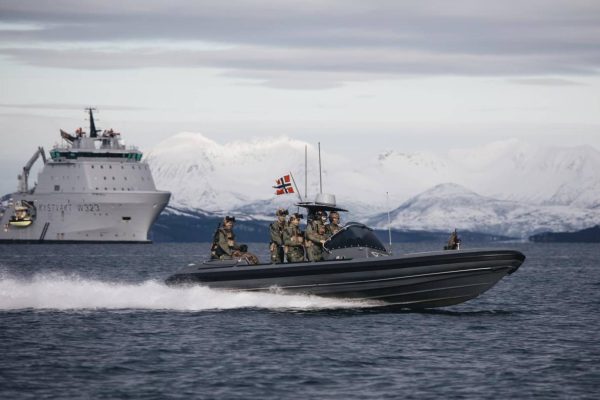Since Russia launched its invasion of Ukraine in February 2022, the naval conflict in the Black Sea has been characterized by a plethora of attacks by unmanned surface vehicles (USVs) and anti-ship cruise missiles (ASCMs).
Imaginative use of these systems has allowed Ukraine to loosen Russia’s grip as the predominant naval force on the Black Sea; it says it has destroyed a total of 15 Russian naval vessels and damaged another 12 units since the start of the conflict. That amounts to a large part of Russia’s regional naval force.
Are NATO navies similarly vulnerable? Not as much. Allied navies have much more advanced anti-missile and radar systems that should pick up approaching threats. Russia’s surface combatants carry obsolete Soviet-era air defenses — as in the case of the Slava-class cruiser Moskva, sunk in 2022 — and have often simply failed to spot, or been unable to engage, USVs and anti-ship missiles like Neptune and Storm Shadow.
We can be fairly certain of this given a number of engagements in the Red Sea in recent weeks. Several US Navy destroyers and a French frigate have successfully intercepted numerous Houthi missile and drone attacks aimed at Israel and against commercial vessels in the Red Sea and Bab El-Mandeb strait. These actions have demonstrated that the US and its allies are well-prepared to defend against these threats, and are investing accordingly in naval capabilities to ensure they remain capable of doing so.
As the US Navy’s Ticonderoga-class cruisers are progressively decommissioned, the upcoming nine Arleigh Burke Flight III guided-missile destroyers to be delivered by 2027 will be equipped with the new AN/SPY-6 air and missile defense radar. Washington is also planning a DDG(X) program to follow the Arleigh Burke class, which is likely to bring vessels with a displacement close to 13,000 tons, featuring an estimated 128 vertical launch missile cells (VLS) cells and improved anti-air warfare (AAW) capabilities.
In Europe, the Royal Navy’s Type 45 AAW destroyers also feature advanced defense systems. Most recently, these ships are set to be fitted with 24 additional VLS cells for the Sea Ceptor missile, which will complement the longer-range Sea Viper systems they already operate. Plans for the new Type 83 destroyer — expected to replace the Type 45 starting mid-2030s — are already underway, with early proposals hinting at a bigger vessel and a higher number of VLS cells.
The French and Italian navies currently operate the Horizon AAW destroyers, equipped with the European Principal Anti-Air Missile System (PAAMS), which will soon undergo a mid-life upgrade. The Italian Navy is also working on a future destroyer program (DDX) to replace its Durand de la Penne-class destroyers, which are expected to be close to 13,000 tons displacement and be fitted with 96 VLS cells.
The German Navy’s Sachsen-class (F124) AAW frigates are set to be replaced during the 2030s with the F127 program, expected to double the number of units and feature a higher number of VLS cells. Like the Royal Navy’s Type 83 and Italy’s DDX, the F127 program will likely be close to 12,000 tons displacement.
All of which, taken with the performance of allied ships in the Red Sea, sounds very encouraging. And yet, much bigger challenges loom on NATO’s horizon.
The primary problem is that NATO navies are not ready yet to withstand the challenges of high-intensity naval conflict.
China is the foremost example of the anti-ship challenge for the US Navy and its allies in the Western Pacific region. Over the last decades, Beijing has developed an extensive arsenal of missiles with which it hopes to keep the US Navy far from its areas of operation near its coasts and in the South China Sea. These missile capabilities are one of the pillars of China’s anti-access/area denial (A2/AD) in the region and would play a crucial role in case it invades Taiwan.
Russia’s cruise missile capabilities have evolved over recent years as part of efforts to establish a credible deterrence against NATO via “the combination of air defenses and cruise missile-equipped ships.” As the Russian Navy gradually replaces its Onik, Granit, and Kalibr arsenals with the Zircon hypersonic missile, the number of cruise missile slots aboard Russian submarines is expected to “more than double from 2020 to 2030” while those of NATO navies decrease – thus hampering their capacity to “fight tonight”.
Furthermore, while successful in defending from UAVs and USVs, “pitting missiles costing hundreds of thousands of dollars against such threats costing a fraction thereof is not a good trade-off unless it prevents a billion dollars of platform damage.”
Rather, to confront these lower-end threats, NATO navies will have to find smart ways of leveraging the advantages provided by unmanned technologies as their foes have done during recent decades – particularly for the protection of maritime commerce and critical undersea infrastructure.
The recent success of US and French ships does not imply NATO is ready for the emerging high-intensity naval challenges. Many of NATO’s current surface combatants still “lack the necessary number of battle force missiles and corresponding VLS cells to conduct and sustain high-end naval operations effectively,” as would be required against China and Russia.
Our naval forces have a lot to do.
Gonzalo Vázquez holds a BA in international relations and is currently working as an Intern at the NATO Crisis Management & Disaster Response Center of Excellence in Bulgaria. He is a junior analyst with the Center for Naval Thought at the Spanish Naval War College, and a regular contributor with the Center for Maritime Strategy in Arlington, VA.
Europe’s Edge is CEPA’s online journal covering critical topics on the foreign policy docket across Europe and North America. All opinions are those of the author and do not necessarily represent the position or views of the institutions they represent or the Center for European Policy Analysis.





